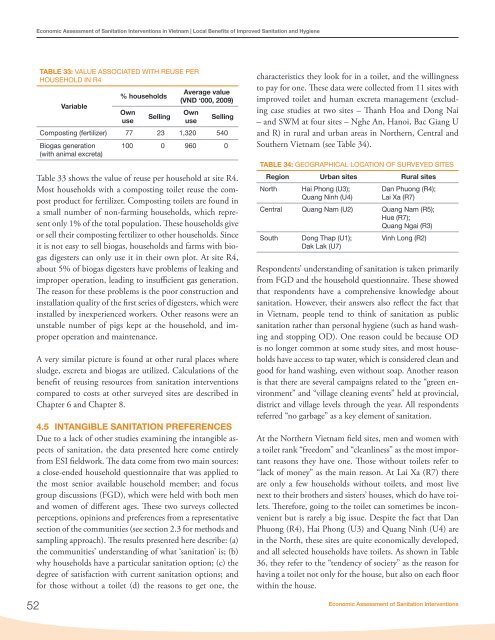Economic Assessment of Sanitation Interventions in Vietnam - WSP
Economic Assessment of Sanitation Interventions in Vietnam - WSP
Economic Assessment of Sanitation Interventions in Vietnam - WSP
You also want an ePaper? Increase the reach of your titles
YUMPU automatically turns print PDFs into web optimized ePapers that Google loves.
<strong>Economic</strong> <strong>Assessment</strong> <strong>of</strong> <strong>Sanitation</strong> <strong>Interventions</strong> <strong>in</strong> <strong>Vietnam</strong> | Local Benefits <strong>of</strong> Improved <strong>Sanitation</strong> and Hygiene52TABLE 33: VALUE ASSOCIATED WITH REUSE PERHOUSEHOLD IN R4Variable% householdsOwnuseSell<strong>in</strong>gAverage value(VND ‘000, 2009)OwnuseSell<strong>in</strong>gCompost<strong>in</strong>g (fertilizer) 77 23 1,320 540Biogas generation(with animal excreta)100 0 960 0Table 33 shows the value <strong>of</strong> reuse per household at site R4.Most households with a compost<strong>in</strong>g toilet reuse the compostproduct for fertilizer. Compost<strong>in</strong>g toilets are found <strong>in</strong>a small number <strong>of</strong> non-farm<strong>in</strong>g households, which representonly 1% <strong>of</strong> the total population. These households giveor sell their compost<strong>in</strong>g fertilizer to other households. S<strong>in</strong>ceit is not easy to sell biogas, households and farms with biogasdigesters can only use it <strong>in</strong> their own plot. At site R4,about 5% <strong>of</strong> biogas digesters have problems <strong>of</strong> leak<strong>in</strong>g andimproper operation, lead<strong>in</strong>g to <strong>in</strong>sufficient gas generation.The reason for these problems is the poor construction and<strong>in</strong>stallation quality <strong>of</strong> the first series <strong>of</strong> digesters, which were<strong>in</strong>stalled by <strong>in</strong>experienced workers. Other reasons were anunstable number <strong>of</strong> pigs kept at the household, and improperoperation and ma<strong>in</strong>tenance.A very similar picture is found at other rural places wheresludge, excreta and biogas are utilized. Calculations <strong>of</strong> thebenefit <strong>of</strong> reus<strong>in</strong>g resources from sanitation <strong>in</strong>terventionscompared to costs at other surveyed sites are described <strong>in</strong>Chapter 6 and Chapter 8.4.5 INTANGIBLE SANITATION PREFERENCESDue to a lack <strong>of</strong> other studies exam<strong>in</strong><strong>in</strong>g the <strong>in</strong>tangible aspects<strong>of</strong> sanitation, the data presented here come entirelyfrom ESI fieldwork. The data come from two ma<strong>in</strong> sources:a close-ended household questionnaire that was applied tothe most senior available household member; and focusgroup discussions (FGD), which were held with both menand women <strong>of</strong> different ages. These two surveys collectedperceptions, op<strong>in</strong>ions and preferences from a representativesection <strong>of</strong> the communities (see section 2.3 for methods andsampl<strong>in</strong>g approach). The results presented here describe: (a)the communities’ understand<strong>in</strong>g <strong>of</strong> what ‘sanitation’ is; (b)why households have a particular sanitation option; (c) thedegree <strong>of</strong> satisfaction with current sanitation options; andfor those without a toilet (d) the reasons to get one, thecharacteristics they look for <strong>in</strong> a toilet, and the will<strong>in</strong>gnessto pay for one. These data were collected from 11 sites withimproved toilet and human excreta management (exclud<strong>in</strong>gcase studies at two sites – Thanh Hoa and Dong Nai– and SWM at four sites – Nghe An, Hanoi, Bac Giang Uand R) <strong>in</strong> rural and urban areas <strong>in</strong> Northern, Central andSouthern <strong>Vietnam</strong> (see Table 34).TABLE 34: GEOGRAPHICAL LOCATION OF SURVEYED SITESRegion Urban sites Rural sitesNorthHai Phong (U3);Quang N<strong>in</strong>h (U4)Dan Phuong (R4);Lai Xa (R7)Central Quang Nam (U2) Quang Nam (R5);Hue (R7);Quang Ngai (R3)SouthDong Thap (U1);Dak Lak (U7)V<strong>in</strong>h Long (R2)Respondents’ understand<strong>in</strong>g <strong>of</strong> sanitation is taken primarilyfrom FGD and the household questionnaire. These showedthat respondents have a comprehensive knowledge aboutsanitation. However, their answers also reflect the fact that<strong>in</strong> <strong>Vietnam</strong>, people tend to th<strong>in</strong>k <strong>of</strong> sanitation as publicsanitation rather than personal hygiene (such as hand wash<strong>in</strong>gand stopp<strong>in</strong>g OD). One reason could be because ODis no longer common at some study sites, and most householdshave access to tap water, which is considered clean andgood for hand wash<strong>in</strong>g, even without soap. Another reasonis that there are several campaigns related to the “green environment”and “village clean<strong>in</strong>g events” held at prov<strong>in</strong>cial,district and village levels through the year. All respondentsreferred “no garbage” as a key element <strong>of</strong> sanitation.At the Northern <strong>Vietnam</strong> field sites, men and women witha toilet rank “freedom” and “cleanl<strong>in</strong>ess” as the most importantreasons they have one. Those without toilets refer to“lack <strong>of</strong> money” as the ma<strong>in</strong> reason. At Lai Xa (R7) thereare only a few households without toilets, and most livenext to their brothers and sisters’ houses, which do have toilets.Therefore, go<strong>in</strong>g to the toilet can sometimes be <strong>in</strong>convenientbut is rarely a big issue. Despite the fact that DanPhuong (R4), Hai Phong (U3) and Quang N<strong>in</strong>h (U4) are<strong>in</strong> the North, these sites are quite economically developed,and all selected households have toilets. As shown <strong>in</strong> Table36, they refer to the “tendency <strong>of</strong> society” as the reason forhav<strong>in</strong>g a toilet not only for the house, but also on each floorwith<strong>in</strong> the house.<strong>Economic</strong> <strong>Assessment</strong> <strong>of</strong> <strong>Sanitation</strong> <strong>Interventions</strong>
















